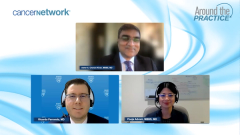
Clinical Case Scenario: A 55-Year-Old Patient With Chronic Lymphocytic Leukemia (CLL)
In a virtual discussion hosted by Asher A. Chanan-Khan, MD, MBBS, experts from Mayo Clinic discuss treatment strategies for chronic lymphocytic leukemia, including the role of cardio-oncology and various therapeutic approaches.
Episodes in this series

Asher A. Chanan-Khan, MD, MBBS: Good morning, and welcome to Cancer Network’s Around the Practice®. Today’s program is titled, “Treatment Strategies in Chronic Lymphocytic Leukemia and Expert Case-Based Discussion.” I’m your host. My name is Dr Asher A. Chanan-Khan. I’m a professor of medicine and professor of oncology at Mayo School of Medicine in Jacksonville, Florida. Today we have a great panel of experts and colleagues that I have known for many years, and I’m very excited to introduce them to you on this virtual discussion panel. I’m sure that you will enjoy their discussion and views on how to manage CLL [chronic lymphocytic leukemia]. First, I will ask Dr Parrondo, who is an expert on B-cell cancers, specifically focused on CLL and multiple myeloma, and is part of our faculty team. [He is a] clinical expert in these diseases and takes care of many patients at Mayo Clinic.
Ricardo D. Parrondo, MD: Good morning, everyone. I’m Dr Ricardo Parrondo, assistant professor of medicine at Mayo Clinic in Jacksonville. It’s a pleasure to be here today and I look forward to our discussion.
Asher A. Chanan-Khan, MD, MBBS: Thank you, Ricardo. Next is Dr Advani, who I’ve known for many, many years, and I have seen her career. Dr Advani has a unique perspective. She’s a leader at Mayo Clinic in the Department of Oncology. She has extensive experience, both in the community and academic settings. In the academic setting, she has developed a fantastic career as a bench-based basic science clinical investigator, and her unique expertise that I wanted to tap into today is her ability to study animal models and the fundamental biology of cardiotoxicity. As we will discuss, you will hear about therapies and cancer as they are evolving. There is a lot of emphasis on cardio-oncology, and Dr Advani has had this unique research interest in trying to address those issues, specifically from a biological perspective. I think having that out-of-the-box experience would be very, very helpful. Dr Advani?
Pooja Advani, MD, MBBS: Thank you so much, Dr Chanan-Khan and the organizers of this panel discussion. I’m one of the medical oncologists at Mayo Clinic, and I’ve done my fellowship here too. I have had the privilege and the pleasure of working with both Dr Chanan-Khan and Dr Parrondo. I’m really excited and looking forward to this discussion and hoping to add some input from a cardio-oncology perspective. Thank you.
Asher A. Chanan-Khan, MD, MBBS: Welcome, both of you. I’m so grateful that you took time off today to be with the audience. And thank you very much to all the audience members who are going to review this program and hopefully our discussion. Our time will be well-served by bringing something new to your knowledge base and translating that into benefit for the patients. We are going to discuss key updates that were presented in recent meetings relevant to the treatment of CLL. We will discuss these updates in the next couple of treatment landscapes, especially in [the] context of a clinical case. Let me start by presenting a case that I think will highlight the clinical problems that we see every day. This is a 55-year-old insurance executive who presented with complaints of progressive fatigue and lymph node enlargement over several months. His family and prior medical history were unremarkable, and physical examination confirmed the presence of extensive cervical and axillary lymph node enlargement ranging between 3 to 5 [cm] in various areas. When the laboratory evaluation was conducted, it demonstrated 123,000 white cells and hemoglobin of 9.6, so mild to moderate anemia with a platelet count of 86,000. A bone marrow biopsy and aspirate were conducted at the time and showed that over 95% of the marrow was actually infiltrated with CLL-like cells. The flow cytometric analysis confirmed that the patient had CLL, and the FISH [fluorescence in situ hybridization] analysis showed 11Q deletion. The patient's disease was staged at 4 based on his less than 100,000 white cell count using the Rai staging system. It was recommended to initiate treatment with systemic therapy for symptomatic disease as per the existing guidelines.... Should we take a chemoimmunotherapy approach...such as FCR [fludarabine, cyclophosphamide, and rituximab] or FR [fludarabine, cyclophosphamide] or BR [bendamustine, rituximab]? Or should we go to the more-targeted therapy, a single agent BTKi, or Bruton tyrosine kinase inhibitor? Should we go for BTKi with a CD20 monoclonal antibody or a BCL-2 monoclonal antibody or BTKi plus BCL-2? All of these options are very relevant to these data.
Newsletter
Stay up to date on recent advances in the multidisciplinary approach to cancer.






















































































